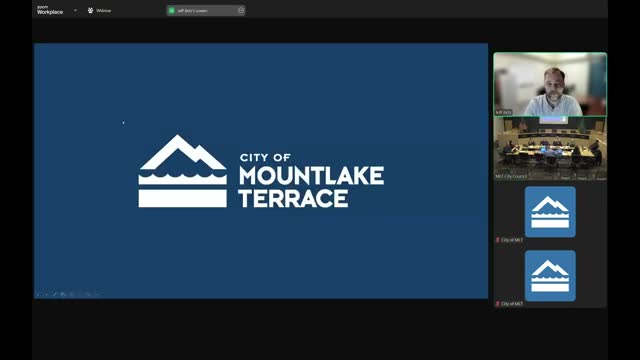City presents options, cost estimates and financing scenarios for replacing 56-year-old Recreation Pavilion
January 12, 2025 | Mountlake Terrace, Snohomish County, Washington
This article was created by AI summarizing key points discussed. AI makes mistakes, so for full details and context, please refer to the video of the full meeting. Please report any errors so we can fix them. Report an error »

City staff told the Mountlake Terrace City Council that the 56-year-old Recreation Pavilion needs replacement and presented cost comparisons, potential financing strategies and next steps for public engagement.
Jeff Betts, the city’s recreation and parks director, said the pavilion was originally paid for with a voter-approved bond in 1964, built in 1968, and “serves about 400,000 users annually.” He summarized a previous Civic Facilities Advisory Task Force recommendation to replace (rather than remodel) the aging facility, and said a 2009 estimate put a possible new facility at $38 million.
Why it matters: replacing or significantly renovating the pavilion would be a multi‑million-dollar capital project with ongoing operational implications. Council members raised two recurring questions: what amenities residents want and how much taxpayers would pay under different funding structures.
Cost and financing options shown to the council included recent and planned regional aquatic/community centers, which city staff used to compute a 2027 median building cost of about $40 million and an approximate hard-construction cost of $880 per square foot (consultants’ aggregate). Betts noted consultants’ advice to add about 40% to hard construction costs to account for soft costs such as design and construction management.
As an example, staff presented a hypothetical $50 million general-obligation bond for Mountlake Terrace alone based on 2023 assessed values (total assessed value cited at about $5.3 billion). Under that scenario, staff calculated an annual debt-service estimate of about $3.75 million and an estimated cost to a typical Mountlake Terrace homeowner (2023 assessed-value example $619,500) of roughly $440 per year (about $37 per month). Staff also described an alternative: a metropolitan park district (MPD) or multi-city district. An MPD can levy up to $0.75 per $1,000 of assessed value and may reduce the per-household cost if several jurisdictions join; staff showed examples that spread the cost across two to four neighboring cities and substantially reduced per-household fees.
Council discussion centered on next steps: several councilors asked for more public outreach to measure residents’ willingness to pay and to identify preferred amenities; others asked for examples of how partnerships and governance (MPD or private partnerships) have worked elsewhere. Betts said staff will develop a public-engagement plan, gather additional comparative examples and return with options informed by community feedback.
Ending: Council members signaled broad interest in pursuing a replacement but differed on scale and financing. Staff will design community engagement and return with more detailed cost, partnership and governance analyses to inform a definitive funding decision.
Jeff Betts, the city’s recreation and parks director, said the pavilion was originally paid for with a voter-approved bond in 1964, built in 1968, and “serves about 400,000 users annually.” He summarized a previous Civic Facilities Advisory Task Force recommendation to replace (rather than remodel) the aging facility, and said a 2009 estimate put a possible new facility at $38 million.
Why it matters: replacing or significantly renovating the pavilion would be a multi‑million-dollar capital project with ongoing operational implications. Council members raised two recurring questions: what amenities residents want and how much taxpayers would pay under different funding structures.
Cost and financing options shown to the council included recent and planned regional aquatic/community centers, which city staff used to compute a 2027 median building cost of about $40 million and an approximate hard-construction cost of $880 per square foot (consultants’ aggregate). Betts noted consultants’ advice to add about 40% to hard construction costs to account for soft costs such as design and construction management.
As an example, staff presented a hypothetical $50 million general-obligation bond for Mountlake Terrace alone based on 2023 assessed values (total assessed value cited at about $5.3 billion). Under that scenario, staff calculated an annual debt-service estimate of about $3.75 million and an estimated cost to a typical Mountlake Terrace homeowner (2023 assessed-value example $619,500) of roughly $440 per year (about $37 per month). Staff also described an alternative: a metropolitan park district (MPD) or multi-city district. An MPD can levy up to $0.75 per $1,000 of assessed value and may reduce the per-household cost if several jurisdictions join; staff showed examples that spread the cost across two to four neighboring cities and substantially reduced per-household fees.
Council discussion centered on next steps: several councilors asked for more public outreach to measure residents’ willingness to pay and to identify preferred amenities; others asked for examples of how partnerships and governance (MPD or private partnerships) have worked elsewhere. Betts said staff will develop a public-engagement plan, gather additional comparative examples and return with options informed by community feedback.
Ending: Council members signaled broad interest in pursuing a replacement but differed on scale and financing. Staff will design community engagement and return with more detailed cost, partnership and governance analyses to inform a definitive funding decision.
View the Full Meeting & All Its Details
This article offers just a summary. Unlock complete video, transcripts, and insights as a Founder Member.
✓
Watch full, unedited meeting videos
✓
Search every word spoken in unlimited transcripts
✓
AI summaries & real-time alerts (all government levels)
✓
Permanent access to expanding government content
30-day money-back guarantee

